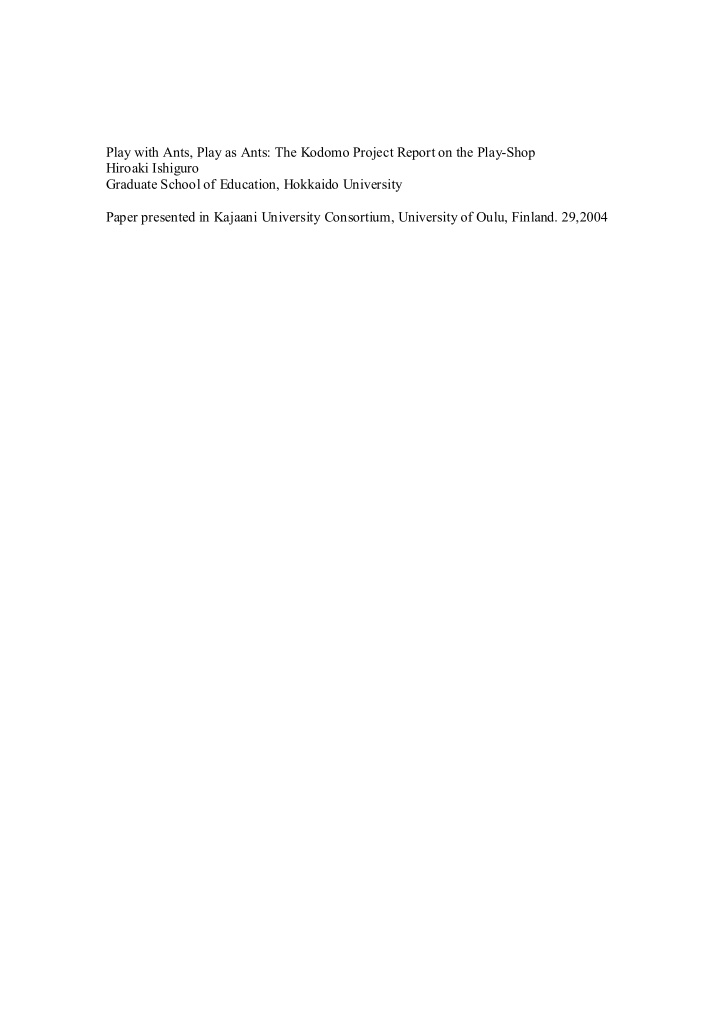



Play with Ants, Play as Ants: The Kodomo Project Report on the Play-Shop Hiroaki Ishiguro Graduate School of Education, Hokkaido University Paper presented in Kajaani University Consortium, University of Oulu, Finland. 29,2004
Play with Ants, Play as Ants: The Kodomo Project Report on the Play-Shop Hiroaki Ishiguro Graduate School of Education, Hokkaido University “If the world is the whole of that which we can understand, the boundary of the narrative act indicates the edge of the world. In this sense, the narrative act is an act of world-making.” (Noe, 2003, p. 66) Background of the Kodomo Project and the Play-Shop The Kodomo Project is an investigation of the developmental processes of play. It is a collaboration between the Ishiguro laboratory of Hokkaido University and the Miharu kindergarten. Since 2003, it has been organizing after-school play activities in a kindergarten, named the “Play-Shop”. The Play-Shop is an implementation of the formative experimental method based on the socio-historical tradition of psychology (see Elkonin, 1978) . It represents a flexible, process-oriented program for play activity. Adults in the Play-Shop are not experimenters, but coaches trained to assist children by taking the perspective of the child into consideration. The program of activity is not completely decided in advance. It is flexible and easily changeable, corresponding to children’s actual activity such that it may be called an “emergent curriculum” (Hendrick, 1997). The participants engage in physical actions, construct compositions using discarded cardboard, and depict a reflected image of the activities of the day. This expressive aspect is an important factor of the play-shop. The background of the Kodomo Project has two aspects. One is the recent need for high quality after-school childcare programs. Normally, nursery schools are only required to provide child-care during daytime, and parents have cared for children at home. But recent changes in Japanese society have created a demand for more extended child-care. Extended kindergarten child-care programs, known as Azukari Hoiku (leaving childcare), have been supported by the Japanese government since the year 2000 (Ministry of Education, Culture, Sports, Science and Technology, 2002) . However the quality of these programs has been poor. The other aspect is related to an educational research interest in the socio- historical perspective on play ( Vygotsky, 1933/1974; Elkonin, 1960; Leont’ev, 1965). Play in the preschool period is considered as a primary activity of children. Scandinavian researchers have been interested in play as a ‘transitory activity’ (Bronstrom, 1999; Hakkarainen, 2004), changing from play activity during the preschool period to learning activity during the school years. There is a need to identify the characteristics of play in the preschool period, and to clarify the role of play activities as a link between the preschool and the school years.
Brief sketch of Play-Shop activities from 2003 to the present Play-Shop activities have been conceptualized as “courses” of three months each. The Play-Shop has now completed four courses. The first course: A trial period for participants. (Oct.2003 to Dec.2003) Note on fig.1: Children crafted trains with corrugated cartons and played with them. Fig. 1 The first course was a trial period for the Play-Shop. The main goal was to get the laboratory staff acclimatized to the setting. Volunteer undergraduate students from around Sapporo and the kindergarten’s staff participated in Play-Shop. Craftwork with discarded cardboard was often the main activity. Interactions in the construction process taught us about children’s characteristic play. The children looked forward to Play-Shop activities, and remembered them long after. The second course: Shopping play (Jan.2004 to Mar.2004) Note on fig.2: Children with adult staffs managed a bank for shoppers. It is a day that they present their play in a regular school class called “ mixed-age nursery class”. Fig. 2 The main goal for staff during the second course was to support children’s role- play. Products from the first term were used for this activity. Craftwork for shopping play was preferred for girls. Madoka analyzed children’s indexical treatment of inscriptions. One child, who could not write a letter, often depicted things in his work and asked staff to write down letters to represent what he depicted. Children inscribed
things to help them remember, to indicate who was an owner, what a product was, and signboards for the shop. Staff supported children’s literacy awareness. The third course: Ants’ world (Apr. 2004 to Jul. 2004) Note on fig.3: Participants played as ants in the nest. They wore a black vinyl bag to turn into an ant. Children have to grovel inside the nest. They enjoyed the constraints. Fig. 3 The focus of the third course was the world of ants, which was a model for how children know the world. Ants appear in the Spring. Sapporo is a cold district, and Spring comes slowly. So the ant is an index for Spring warmth. Staff read aloud picture books for children, and the children looked at the pictures. They also watched on original ant video, where staff fed ants on the ground. Children played as ants in the nest. They collaboratively drew ants’ activities on a large paper. Many of the children were interested in ants. We focused on tasks related to “knowing” through this course. How do they know an ant? What is “knowing” for them? What is an experience? What did they build up through their play activities? These epistemological inquires were carried forward to the current Fall course. The current course: Picture-drama making activities (Aug. 2004 to Oct. 2004) Note on fig.4: Sachiko, who is one of graduate students as staff, narrated the story in corresponding to each child’s picture. The story was improvised by their conversation on the pictures.(2004/10/21) Fig. 4 The main activity of Play-Shop in this Fall period was to make collaboratively a picture-drama of a grasshopper and an ant. The story of the grasshopper and the ant is a famous one in Aesop’s Fables . A picture-drama is composed of several pictures, and a narrator successively tells the story corresponding to each picture. It is called “Kami
Recommend
More recommend